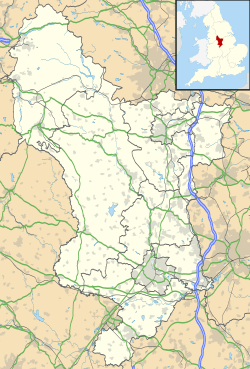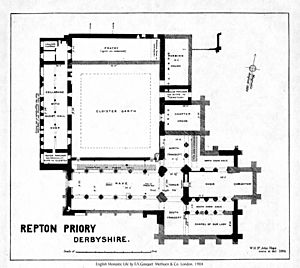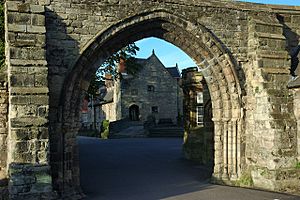Repton Priory facts for kids
| Monastery information | |
|---|---|
| Other names | Prior and Canonry of Holy Trinity of Repton and the Canonry of St. Giles of Calke |
| Established | 12th-Century |
| Disestablished | 1538 |
| Mother house | Calke Priory |
| Diocese | Diocese of Lichfield |
| Controlled churches |
|
| People | |
| Founder(s) | Maud of Gloucester, Countess of Chester |
| Site | |
| Location | Repton, Derbyshire, England, United Kingdom. |
| Coordinates | 52°50′29″N 1°33′01″W / 52.8413°N 1.5504°W |
| Visible remains | Only small fragments remain: mainly footings and foundations |
Repton Priory was an important priory (a type of religious house) located in Repton, Derbyshire, England. It was first built in the 1100s. A priory was a place where Augustinian canons (religious men who followed strict rules) lived and prayed.
People used to visit Repton Priory because of a special shrine to St Guthlac. They believed that if they placed their head on his bell, it would cure their headaches! The priory was eventually closed down in 1538.
A Look Back in Time
In the 1100s, a powerful woman named Maud of Gloucester, Countess of Chester owned the land in Repton. After her husband passed away in 1153, she gave St Wystan's Church to the Augustinian canons who lived at Calke Priory.
Countess Maud then decided to build a brand new priory in Repton. She dedicated it to the Holy Trinity. At first, Repton Priory was like a smaller branch of Calke Priory. But Countess Maud had a condition: most of the canons from Calke should move to the new Repton Priory as soon as possible. This happened in 1172. From then on, Repton Priory became the main priory, and Calke Priory became its smaller branch. For many years, the priory was known as the "Prior and Canonry of Holy Trinity of Repton and the Canonry of St. Giles of Calke."
The priory buildings in medieval times included a church, a cloister (an open area surrounded by covered walkways), a chapter house (where meetings were held), a refectory (dining hall), and the prior's (leader's) own rooms. There were also other buildings nearby.
In 1220, a man named Nicholas de Willington gave the priory control over the church in Willington. He did this so the canons would pray for him and his family.
The priory received official confirmations from important people. In 1271, the Bishop of Coventry and Lichfield confirmed its rights. The next year, King Henry III also confirmed them. These documents made sure Repton Priory had control over St Wystan's Church and its eight smaller chapels in nearby villages like Bretby and Ticknall. They also confirmed control over churches in Croxall, Willington, and Baddow in Essex.
In 1291, records show that the priory earned a good income from its lands and from St Wystan's Church. Because they had a lot of land, the prior was even asked to send soldiers to a gathering in Nottingham in 1297!
The priory was originally supported by Countess Maud's family. But over time, control of the priory passed to the King. This happened after John Balliol, a former King of Scotland, lost all his land to King Edward I.
What Happened to the Priory?
In 1535, a survey showed that Repton Priory had a yearly income of about £118. This was less than £200, which meant it was considered a "small monastery." Because of this, Repton Priory was chosen to be closed down by King Henry VIII during his dissolution (closing) of monasteries in 1536.
However, Repton Priory was one of the few that managed to reopen! In 1537, the prior, John Young, paid the King a very large sum of money (about £266) to save the priory. But this only worked for one more year. On October 25, 1538, the priory was finally given over to the King for good.
The prior, John Young, sadly died just three days before the final agreement was signed. The other canons who lived at the priory were given yearly payments (called pensions) so they would have money to live on.
After the priory was closed, its buildings were given to a man named Thomas Thacker. When he died, his son Gilbert Thacker took over. Gilbert was worried that if a Catholic queen came to power, the priory might be used for religious purposes again. So, he ordered that the priory be completely destroyed. It was almost entirely torn down in just one day! Gilbert Thacker famously said he wanted to "destroy the nest, for fear the birds should build therein again."
In 1557, Sir John Port passed away. In his will, he left money to create a "Grammar School in Etwalle or Reptone." In 1559, the people in charge of his will bought the old priory site from the Thacker family. This site then became Repton School, which is still a famous school today.
What Remains Today?
Only small parts of the original priory buildings are left. Some of the foundations (the lowest parts of the walls) of the prior's old rooms, from around 1438, are now part of a building at Repton School. Most of this building is from later centuries.
Other parts of the priory's foundations were found during building work at Repton School in 1922. You can still see the bases of some columns from the old church. There are also pieces of an arch that were moved to their current spot in 1906. And you can find fragments of the doorframes from the chapter house and the warming room.
Priors of Repton
These are the names of the leaders (Priors) of Repton Priory:
- Robert, around 1153–1160
- Nicholas, around 1172–1181
- Albred, around 1200
- Richard, around 1208
- Nicholas, around 1215
- John, around 1220
- Reginald, around 1230
- Peter, around 1252
- Robert, around 1289
- Ralph, 1316–36
- John de Lichfield, 1336–46
- Simon de Sutton, 1346–56
- Ralph of Derby, 1356–99
- William of Tutbury, 1399–
- William Maynesin, around 1411
- Wystan Porter, ?–1436; resigned
- John Overton, 1436–38; died in office
- John Wylne, 1438–71
- Thomas Sutton, 1471–86
- Henry Prest, 1486–1503
- William Derby, 1503–08
- John Young, 1508–36, and 1537–38; died in office




